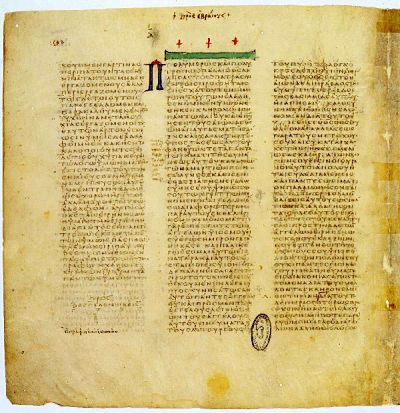Revelation 20:5 - A Maliciously Inserted Delay
- Details
- Category: Salvation

Theme Text– (The rest of the dead did not come to life until the thousand years were ended.) This is the first resurrection (Revelation 20:5).
The Problem
1) What do the Scriptures say with regards to the upcoming thousand-year kingdom of Christ?
- The Bible forecasts that when Christ returns there will be a resurrection of all mankind from the dead by means of the ransom price Jesus paid for Adam on the cross (“Life for Life”) in order to redeem us all from death (Hosea 13:14, 1Timothy 2:6, 1Corinthians 15:21-22).
- The Bible also classifies the resurrection of mankind to be of two types:
- People of the First Resurrection – These are the followers of Christ who successfully prove their faith in him till death. They will rise to a special type of celestial resurrection where they shall rule with Christ over the rest of the resurrected mankind (i.e. the people of the second type of resurrection) for a thousand years (Revelation 20:6; 2:26-27; 5:10; 3:21, 2Timothy 2:12, 1Corinthians 15:40).
- People of the Second Resurrection – These are the rest of mankind who will rise to a terrestrial resurrection on Earth to learn righteousness under the thousand-year reign of Christ & his followers, and then be judged at the end of it (Acts 3:20-21, Isaiah 26:9, 1Corinthians 6:2).
- Thus, the thousand-year reign that shall commence after these two types of resurrection will have a specific purpose –
- Its goal would be the rehabilitation of the resurrected mankind under the reign of Christ and his victorious followers.
- Christ and his rulers will teach righteousness to the resurrected mankind.
- Even Satan shall be kept bound during these thousand years so that he does not interfere with the subjects of the Kingdom when they are being taught righteousness by their heavenly rulers (Revelation 20:1-2).
2) What is the problem posed by the text of Revelation 20:5?
The verse under question has two parts as below:
- 5.a - (The rest of the dead did not come to life until the thousand years were ended.)
- 5.b - This is the first resurrection.

The first part 5.a stands in contradiction with the rest of the Bible, especially with all the Scriptures we saw earlier that describe the purpose of the thousand-year kingdom to come.
- If the rest of mankind would not come to life and remained dead until the thousand-year rule ends, then that reign would have no purpose or cause.
- The People of the First Resurrection would be reigning over an empty planet as dummy rulers for no reason at all.
- There are some who try to claim that those rulers would just reign over the last human generation left alive on the planet at that given instant. But that theory bears neither scriptural testimony nor does it explain why only the last generation of humans deserves special treatment in learning righteousness under Christ & his followers, amidst special conditions of even Satan being bound - whereas all the earlier human generations had been left high and dry under Satan.
Thus, the verse Revelation 20:5a poses a significant problem to scriptural harmony – not only by contradicting with quite a lot of solid verses but also by essentially nullifying the all-important purpose of the Kingdom of Christ that is to come on the Earth.
As the Lord Jesus advised his followers, "Seek and ye shall find", it's indeed worthwhile to spend time seeking the written Scriptures for the truth. When we look at the context of Revelation 20:5 and search the manuscripts of the text of Revelation we find some interesting answers in this regard.
1. Context
The verses that provide the context surrounding Revelation 20:5 are as below.
Revelation 20:
- 4 - They came to life and reigned with Christ a thousand years.
- 5.a - (The rest of the dead did not come to life until the thousand years were ended.)
- 5.b - This is the first resurrection.
- 6 - Blessed and holy are those who share in the first resurrection.
Thus, we see that verses 4-6 are in essence providing a coherent description of the first type of resurrection. Now let us focus on the 5.a part.
2. Manuscripts
Rev 20: 5.a - (The rest of the dead did not come to life until the thousand years were ended.)
When we search the earliest manuscripts, we arrive at below findings:
- The sentence 5.a is not found in the oldest and most reliable manuscripts, including the Sinaitic and Syriac.
- About 40% of the 200 available manuscripts of Revelation do not have 5.a.
- 50% of the earliest manuscripts from 4th-13th centuries do not have it.
- Going back further in time, the earliest manuscript available for Revelation is the Revelation commentary by Victorinus of Pettau (from 300 AD). And that commentary's manuscripts do not have 5.a.
- Even in the manuscripts where 5.a is found, it is present in highly inconsistent forms
- In some scripts, it’s there only in the margins and not as part of the text
- Some have it starting with a ‘But’ whereas others prefix it with an ‘And’
- Some manuscripts that came much later have the ‘again’ whereas others do not
- The Anchor Bible describes the manuscripts’ evidence against 5.a.
Thus, when we verify the manuscripts, we find that this portion that says the rest of the dead did not rise to life until the end of the thousand years, was not really part of the original Bible. This would imply that someone inserted this part in later manuscripts with potentially ulterior motives.
3. The Insertion History
- As stated by several Scriptures, believers since the first century expected the resurrection of all mankind - i.e. “All the dead will rise!” – to happen when Christ returns to establish his Kingdom.
- When Emperor Constantine came to power, he declared Christianity as the official religion of his Empire and got the Christian Church merged with the Roman State.
- Gradually, in order to gain control over the masses, Rome started making claims that Christ's thousand-year Kingdom/Empire had been established right then by the Roman Empire itself.

- But there was a problem with that claim. It faced a major glitch - If the Roman Empire was indeed Christ’s own kingdom, then why had the promised resurrection not happened then?
- The answer to that question was the primary motive for inserting 20:5a into the text. In order to prove that the Roman Empire was indeed Christ’s Empire, the resurrection of the masses had to be delayed further away past the times of the Empire’s projected thousand-year reign.
- So, potentially a scribe from the fourth or early-fifth century, under the influence of the Roman Empire, first added a comment in the margin, 'The rest of the dead lived not until the thousand years were finished.'
- A later scribe moved it off the margins and into the text.
- It still didn't gel with its context, so some scribes tried to prefix an 'And', while others put in a 'But'.
- Scribes who came much later inserted an 'again' after the 'lived not'.
- Thus 5.a is found in various inconsistent forms even in the manuscripts that have it.
Conclusion
D.D. Whedon writes in his ‘Commentary on the New Testament’ about Revelation 20:5a:
“There is a suspicious number of variations in copies containing the sentence. There are three variations in the Greek of the words but the rest; three variations of the word for lived; two for until… The sentence, like an interpolation, interrupts the current of the style. It breaks in between the next word, this, and the antecedent to which its affirmation refers. The sentence reads like an explanatory note by some copyist, which has been wrought into the text, and that in a very awkward position… no sound biblical scholar will now consider it worthy reliance...”
As a matter of fact, when we omit 5.a and read verses 4, 5.b and 6, we see a continuous flow of coherent narration, whereas 5.a stands out like a sore thumb, interrupting the narrative, forcing some Bible versions (eg. NIV) to even place it within parentheses. There is one plain reason for that. It was not there in the original. It was not part of the Bible. It was spuriously inserted by later scribes with malicious intent, ignoring the dire warnings about such actions by the book itself (Revelation 22:18), as Satan boldly tried to hijack Christ’s Empire for himself in the Roman Empire’s name.
According to the original Bible, Revelation 20:4-6 should read as below:
- 4 - They came to life and reigned with Christ a thousand years.
- 5.b - This is the first resurrection.
- 6 - Blessed and holy are those who share in the first resurrection.
Yes, there are indeed two types of resurrections, but they are not set apart by thousand years. They are rather different in the sense that those of the first resurrection – the proven believers - get to sit on thrones with Christ and reign over those of the second resurrection - the rest of mankind – in order to teach them righteousness.
The thousand-year Kingdom of Christ will have a glorious purpose and that shall be the rehabilitation and restitution of the resurrected mankind under the heavenly rulership of Christ and his risen followers. Jesus himself labeled it as the “Renewal of All Things” (Matthew 19:28) and Peter deemed it as the “Times of Restitution of All Things” (Acts 3:21).
Amen, let us pray – “Thy kingdom come! Thy will be done on the Earth as it is in the Heavens!
